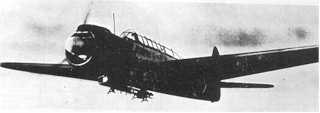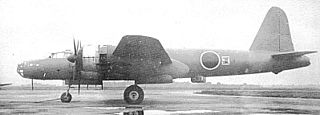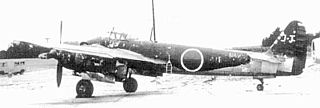Development and design
The C6N originated from a 1942 Imperial Japanese Navy specification for a carrier-based reconnaissance plane with a top speed of 350 knots (650 km/h) at 6,000 m and range of 2,500 nautical miles (4,960 km). [1] Nakajima's initial proposal, designated N-50, was for a craft with two 1,000 hp (750 kW) engines housed in tandem in the fuselage, driving two propellers mounted on the wings. With the development of the 2,000 hp (1,500 kW) class Nakajima Homare engine, the dual powerplant configuration was abandoned and Nakajima decided on a more conventional single-engine layout. Unfortunately the new Homare's power output was less than expected, and the design had to be optimized in other areas. The resulting aircraft was designed around a long and extremely narrow cylindrical fuselage just large enough in diameter to accommodate the engine. The crew of three sat in tandem under a single canopy, while equipment was similarly arranged in a line along the fuselage. The C6N's low-mounted laminar flow wing housed fuel tanks and was fitted with both Fowler and slit flaps and leading-edge slats which lowered the aircraft's landing speed to ease use aboard aircraft carriers. [2] Like Nakajima's earlier B6N Tenzan torpedo bomber, the vertical stabilizer was angled slightly forward to enable tighter packing on aircraft carrier decks.
The C6N's first flight was on 15 May 1943, with the prototype demonstrating a speed of 639 km/h (345 kn; 397 mph). [3] Performance of the Homare engine was disappointing, especially its power at altitude, [3] and a series of 18 further prototypes and pre-production aircraft were built before the Saiun was finally ordered into production in February 1944. [3] [4]
Operational history
Although designed for carrier use, by the time it entered service in September 1944 there were few carriers left for it to operate from, so most C6Ns were flown from land bases. Its speed was exemplified by a telegraph sent after a successful mission: "No Grummans can catch us." ("我に追いつくグラマンなし"). The top speed of the Hellcat was indeed of the same level, so overtaking a Saiun was out of the question. [3] [5]
A total of 463 aircraft were produced. [6] A single prototype of a turbocharged development mounting a 4-blade propeller was built; this was called the C6N2 Saiun-kai. Several examples of a night fighter version C6N1-S with oblique-firing ( Schräge Musik configuration) single 30 mm (or dual 20 mm) cannon were converted from existing C6N1s. As Allied bombers came within reach of the Japanese home islands, a first class night fighter was required. This led Nakajima to develop the C6N1-S by removing the observer and replacing him with two 20 mm cannons. The C6N1-S's effectiveness was hampered by the lack of air-to-air radar, although it was fast enough to enjoy almost complete immunity from interception by Allied fighters. A torpedo carrying C6N1-B was also proposed, but was not needed after most of Japan's aircraft carriers were destroyed.
Despite its speed and performance, on 15 August 1945 a C6N1 happened to be the last aircraft to be shot down in World War II. Just five minutes later, the war was over and all Japanese aircraft were grounded. [6]

The Aichi B7A Ryusei was a large and powerful carrier-borne torpedo-dive bomber produced by Aichi Kokuki for the Imperial Japanese Navy Air Service during the Second World War. Built in only small numbers and deprived of the aircraft carriers it was intended to operate from, the type had little chance to distinguish itself in combat before the war ended in August 1945.

The Mitsubishi A5M, formal Japanese Navy designation Mitsubishi Navy Type 96 Carrier-based Fighter (九六式艦上戦闘機), experimental Navy designation Mitsubishi Navy Experimental 9-Shi Carrier Fighter, company designation Mitsubishi Ka-14, was a WWII-era Japanese carrier-based fighter aircraft. The Type number is from the last two digits of the Japanese imperial year 2596 (1936) when it entered service with the Imperial Navy.

The Yokosuka D4Y Suisei is a two-seat carrier-based dive bomber developed by the Yokosuka Naval Air Technical Arsenal and operated by the Imperial Japanese Navy from 1942 to 1945 during World War II. Development of the aircraft began in 1938. The first D4Y1 was complete in November 1940 and made its maiden flight at Yokosuka the following month.

The Nakajima B6N Tenzan was the Imperial Japanese Navy's standard carrier-borne torpedo bomber during the final years of World War II and the successor to the B5N "Kate". Due to its protracted development, a shortage of experienced pilots and the United States Navy's achievement of air superiority by the time of its introduction, the B6N was never able to fully demonstrate its combat potential.

The Kawanishi N1K is an Imperial Japanese Navy fighter aircraft, developed in two forms: the N1K Kyōfū, a floatplane designed to support forward offensive operations where no airstrips were available, and the N1K-J Shiden, a land-based version of the N1K. The N1K-J was considered by both its pilots and opponents to be one of the finest land-based fighters flown by the Japanese during World War II.

The Nakajima Aircraft Company was a prominent Japanese aircraft manufacturer and aviation engine manufacturer throughout World War II. It continues as the car and aircraft manufacturer Subaru.

The Mitsubishi A7MReppū was designed as the successor to the Imperial Japanese Navy's A6M Zero, with development beginning in 1942. Performance objectives were to achieve superior speed, climb, diving, and armament over the Zero, as well as better maneuverability – all parameters that were ultimately achieved towards the end of its development in 1945. However, limitations on Japanese industry towards the end of the war prevented the A7M from ever entering mass production or being deployed for active duty, and it never saw active service. Its Allied reporting name was "Sam".

The Mitsubishi Ki-46 was a twin-engine reconnaissance aircraft that was used by the Imperial Japanese Army in World War II. Its Army Shiki designation was Type 100 Command Reconnaissance Aircraft (一〇〇式司令部偵察機); the Allied brevity code name was "Dinah".

The Nakajima G8N Renzan was a four-engined long-range bomber designed for use by the Imperial Japanese Navy. The Navy designation was "Type 18 land-based attack aircraft" (十八試陸上攻撃機); the Allied code name was "Rita".

The Nakajima Ki-84 Hayate is a single-seat fighter flown by the Imperial Japanese Army Air Service in the last two years of World War II. The Allied reporting name was "Frank"; the Japanese Army designation was Army Type 4 Fighter. The Ki-84 is generally considered the best Japanese fighter to operate in large numbers during the conflict. The aircraft boasted high speed and excellent maneuverability with an armament that gave it formidable firepower. The Ki-84's performance matched that of any single-engine Allied fighter it faced, and its operational ceiling enabled it to intercept high-flying B-29 Superfortress bombers. Pilots and crews in the field learned to take care with the plane's high-maintenance Nakajima Homare engine and landing gear prone to buckling. The difficulties of Japan's situation late in the war took a toll on the aircraft's field performance as manufacturing defects multiplied, good quality fuel proved difficult to procure, and experienced pilots grew scarce. Nevertheless, a well-maintained Ki-84 was Japan's fastest fighter. A total of 3,514 aircraft were built.

The Nakajima J1N1 Gekkō is a twin-engine aircraft used by the Imperial Japanese Navy during World War II. A prototype first flew in May 1941. The first full production variant of the Gekkō, the J1N1-C was a reconnaissance aircraft, although many of these underwent field modification into night fighters; in addition, a night fighter variant, the J1N1-S was later put into production. Towards the end of the war, J1N1 pilots also undertook kamikaze anti-shipping missions. The Gekkō was given the Allied reporting name "Irving".

The Yokosuka P1Y Ginga is a twin-engine, land-based bomber developed for the Japanese Imperial Navy in World War II. It was the successor to the Mitsubishi G4M and given the Allied reporting name "Frances".

The Nakajima J5N was an abandoned Japanese prototype fighter aircraft of the World War II era. J5N was developed as twin-engine interceptor for countering attacks by Boeing B-29 Superfortress.

The Aichi D1A or Navy Type 94/96 Carrier Bomber was a Japanese carrier-based dive bomber of the 1930s. A single-engine, two-seat biplane based on the Heinkel He 50, the D1A was produced by Aichi for the Imperial Japanese Navy, remaining in service as a trainer at the time of the attack on Pearl Harbor. The D1A was produced in two variants, the D1A1, and the D1A2.

The Nakajima G5N Shinzan was a four-engined long-range heavy bomber designed and built for the Imperial Japanese Navy prior to World War II. The Navy designation was "Experimental 13-Shi Attack Bomber"; the Allied code name was "Liz".

The Nakajima Ki-49Donryu was a twin-engine Japanese World War II heavy bomber. It was designed to carry out daylight bombing missions, without the protection of escort fighters. Consequently, while its official designation, Army Type 100 Heavy Bomber, was accurate in regard to its formidable defensive armament and armor, these features restricted the Ki-49 to payloads comparable to those of lighter medium bombers – the initial production variant could carry only 1,000 kg (2,200 lb) of bombs.

The Nakajima E8N was a Japanese ship-borne, catapult-launched, reconnaissance seaplane of the Second Sino-Japanese War. It was a single-engine, two-seat biplane with a central main-float and underwing outriggers. During the Pacific War, it was known to the Allies by the reporting name "Dave". This aircraft was identified by the British as the Nakajima KT-95 Dave.

The Aichi E16A Zuiun was a two-seat reconnaissance seaplane operated by the Imperial Japanese Navy during World War II.

The Aichi S1A Denko was a Japanese night fighter, intended to replace the Nakajima J1N1-S Gekkou. Like the Gekkou, it was to be equipped with radar to counter the B-29 air raids over Japan. Development time for the S1A increased while trying to overcome design shortcomings, such as the insufficient power of the Navy's requested Nakajima Homare engines, resulting in no aircraft being completed before the war ended.
The Nakajima D3N was a Japanese carrier-based dive bomber of the 1930s. Three prototypes were built for the Imperial Japanese Navy, but no production followed, with the Aichi D3A being selected instead.




















